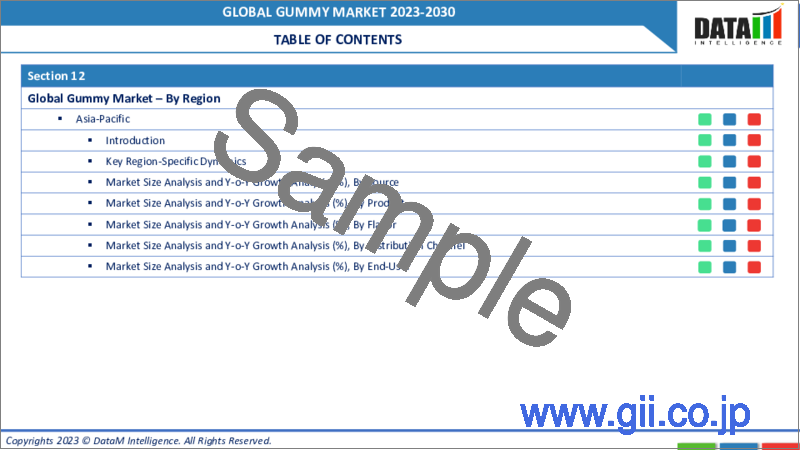|
|
市場調査レポート
商品コード
1316259
グミの世界市場:2023年~2030年Global Gummy Market - 2023-2030 |
||||||
カスタマイズ可能
適宜更新あり
|
|||||||
| グミの世界市場:2023年~2030年 |
|
出版日: 2023年07月27日
発行: DataM Intelligence
ページ情報: 英文 190 Pages
納期: 即日から翌営業日
|
- 全表示
- 概要
- 目次
市場概要
グミの世界市場は2022年に192億米ドルに達し、2030年には405億米ドルに達すると予測され、予測期間2023-2030年のCAGRは9.8%で成長する見込みです。機能性グミの需要増加、グミ市場は、ビタミン、ミネラル、その他の健康増進成分を配合した機能性グミの需要が急増しており、消費者は便利で楽しい方法で健康全般をサポートする方法を求めています。
グミ市場は、嗜好性が高く便利なスナックに対する消費者の需要の増加などの要因によって、力強い成長を遂げています。グミはその楽しい食感と幅広いフレーバーで知られ、あらゆる年齢層の消費者にアピールしています。フレーバー、原材料、パッケージの絶え間ない革新により、グミ市場はさらなる拡大の態勢を整えており、既存ブランドと新興プレーヤーの双方にとって大きな可能性を秘めています。
健康志向の間食習慣がグミ市場を後押ししており、消費者は栄養価の高い嗜好品をますます求めるようになっています。グミメーカーは、低糖質、オーガニック、栄養強化オプションなど、より健康的な処方を導入することでこの動向に対応し、健康志向の消費者の需要に応えています。
市場力学
健康とウェルネスが栄養強化グミの需要を牽引
グミ市場の動向は、消費者の間で健康とウェルネスへの関心が高まっていることが原動力となっています。個人の健康が重視される中、個人は利便性と栄養価の両方を提供するグミを求めています。ビタミン、ミネラル、ハーブエキスが配合されたグミはこの傾向に対応し、食生活を補う便利な方法を提供しています。市場では、グミの望ましい食感と構造を確保するために、ゼラチンやペクチンのようなゲル化剤が使用されています。
さらに、果物や野菜に由来する天然香料や着色料が含まれているため、クリーン・ラベル運動に合致し、自然で健康的な製品を好む健康志向の消費者にアピールしています。健康増進効果のあるグミへの需要が、引き続き市場の成長を牽引しています。
グミ市場は革新的でカスタマイズされた製品で躍進する
進化する消費者の嗜好に対応しようとメーカーが努力しているため、製品の革新とカスタマイズがグミ市場を牽引しています。グミはフレーバー、テクスチャー、形状を試すための多目的なプラットフォームを提供します。企業はゼラチンやペクチンのようなゲル化剤を活用して、ユニークなフレーバーの組み合わせ、斬新な形状、個人に合わせた配合など、多種多様なグミ製品を生み出しています。
着色料の使用は、魅力的で視覚に訴えるグミを可能にします。また、食感改良剤を使用することで、お好みの噛みごたえや柔らかさを実現し、全体的な食感を向上させることができます。継続的な製品革新とカスタマイズにより、グミ・メーカーは消費者の注目を集め、市場成長を牽引しています。
専門的なグミや原材料の入手が限られていることが菓子類を阻害しています
グミ市場における抑制要因は、激しい競争と市場の飽和です。グミの人気は多数のプレーヤーの参入につながり、その結果、混雑した競争の激しい情勢となっています。既存ブランドだけでなく新規参入企業も市場シェアを争っており、価格競争や積極的なマーケティング戦略につながっています。さらに市場は、さまざまなフレーバー、形状、配合を含む幅広いグミ製品で飽和状態にあります。
この飽和状態により、各ブランドが差別化を図り、消費者の関心を引くことが課題となっています。製品差別化の機会が限られているため、メーカーは競争市場で際立つ独自の価値提案を開発するという抑制要因に直面しています。持続的な成長と市場での成功には、効果的なブランディング、イノベーション、戦略的パートナーシップが不可欠となります。
COVID-19インパクト分析
COVID-19分析には、COVID前シナリオ、COVIDシナリオ、COVID後シナリオに加え、価格力学(COVID前シナリオと比較したパンデミック中およびパンデミック後の価格変動を含む)、需給スペクトラム(取引制限、封鎖、およびその後の問題による需給の変化)、政府の取り組み(政府機関による市場、セクター、産業を活性化させる取り組み)、メーカーの戦略的取り組み(COVID問題を緩和するためにメーカーが行ったことをここで取り上げる)が含まれます。
目次
第1章 調査手法と調査範囲
第2章 市場の定義と概要
第3章 エグゼクティブサマリー
第4章 市場力学
- 市場への影響要因
- 促進要因
- 抑制要因
- 機会
- 影響分析
第5章 産業分析
- ポーターのファイブフォース分析
- サプライチェーン分析
- 価格分析
- 規制分析
第6章 COVID-19分析
第7章 供給源別
- 植物由来
- 動物由来
第8章 フレーバー別
- シトラス
- ベリー
- トロピカルフルーツ
- その他
第9章 流通チャネル別
- スーパーマーケット/ハイパーマーケット
- コンビニエンスストア
- オンラインストア
- その他
第10章 地域別
- 北米
- 米国
- カナダ
- メキシコ
- 欧州
- ドイツ
- 英国
- フランス
- イタリア
- スペイン
- その他欧州
- 南米
- ブラジル
- アルゼンチン
- その他南米
- アジア太平洋
- 中国
- インド
- 日本
- オーストラリア
- その他アジア太平洋地域
- 中東・アフリカ
第11章 競合情勢
- 競合シナリオ
- 市況/シェア分析
- M&A分析
第12章 企業プロファイル
- The Kraft Heinz Company
- 会社概要
- 製品ポートフォリオと説明
- 財務概要
- 主な発展
- Mars, Incorporated
- Haribo GmbH & Co. KG
- Nestle S.A.
- Ferrara Candy Company
- Perfetti Van Melle
- Albanese Confectionery Group, Inc.
- Black Forest GmbH
- Jelly Belly Candy Company
- Hershey Company.
第13章 付録
Market Overview
The Global Gummy Market reached US$ 19.2 billion in 2022 and is expected to reach US$ 40.5 billion by 2030 and is expected to grow with a CAGR of 9.8% during the forecast period 2023-2030. Rising Demand for Functional Gummies, the gummy market is witnessing a surge in demand for functional gummies infused with vitamins, minerals, and other health-enhancing ingredients, as consumers seek convenient and enjoyable ways to support their overall well-being.
The gummy market is experiencing robust growth, driven by factors such as increasing consumer demand for indulgent and convenient snacks. Gummies, known for their enjoyable texture and wide range of flavors, appeal to consumers of all ages. With continuous innovation in flavors, ingredients, and packaging, the gummy market is poised for further expansion and holds significant potential for both established brands and emerging players.
The driver of health-conscious snacking habits is propelling the gummy market, as consumers increasingly seek out indulgent treats that offer nutritional benefits. Gummy manufacturers are responding to this trend by introducing healthier formulations, such as low-sugar, organic, and fortified options, to meet the demands of health-conscious consumers.
Market Dynamics
Health and Wellness Drive Demand for Nutrient-Enriched Gummies
The gummy market trend is driven by the growing focus on health and wellness among consumers. With a strong emphasis on personal well-being, individuals are seeking gummies that offer both convenience and nutritional benefits. Gummies formulated with vitamins, minerals, and herbal extracts cater to this trend, providing a convenient way to supplement one's diet. The market is witnessing the use of gelling agents like gelatin and pectin to ensure the desired texture and structure of the gummies.
Additionally, the inclusion of natural flavoring agents and coloring agents derived from fruits and vegetables aligns with the clean label movement, appealing to health-conscious consumers who prefer natural and wholesome products. The demand for gummies with health-enhancing properties continues to drive the growth of the market.
Gummy Market Surges Ahead with Innovative and Customized Offerings
Product innovation and customization are driving the gummy market as manufacturers strive to meet evolving consumer preferences. Gummies offer a versatile platform for experimentation with flavors, textures, and shapes. Companies are leveraging gelling agents like gelatin and pectin to create a wide variety of gummy products, including unique flavor combinations, novelty shapes, and personalized formulations.
The use of coloring agents allows for attractive and visually appealing gummies. Texture modifiers ensure the desired chewiness or softness, enhancing the overall eating experience. With continuous product innovation and customization, gummy manufacturers are capturing consumer attention and driving market growth.
Limited Availability of Specialized Gummy and Ingredients Hampers Confectionery Sector
A restraint in the gummy market is the presence of intense competition and market saturation. The popularity of gummies has led to the entry of numerous players, resulting in a crowded and highly competitive landscape. Established brands, as well as new entrants, are vying for market share, leading to price wars and aggressive marketing strategies. Moreover, the market is saturated with a wide range of gummy products, including various flavors, shapes, and formulations.
This saturation makes it challenging for brands to differentiate themselves and capture consumer attention. With limited opportunities for product differentiation, manufacturers face the restraint of developing unique value propositions to stand out in a competitive market. Effective branding, innovation, and strategic partnerships become crucial for sustained growth and market success.
COVID-19 Impact Analysis
The COVID-19 Analysis includes Pre-COVID Scenario, COVID Scenario, and Post-COVID Scenario along with Pricing Dynamics (Including pricing change during and post-pandemic comparing it to pre-COVID scenarios), Demand-Supply Spectrum (Shift in demand and supply owing to trading restrictions, lockdown, and subsequent issues), Government Initiatives (Initiatives to revive market, sector or Industry by Government Bodies) and Manufacturers Strategic Initiatives (What manufacturers did to mitigate the COVID issues will be covered here).
Segment Analysis
The global gummy market has been segmented by source, flavor, distribution channel, and region.
Plant-Based Gummies Surge in Popularity, Captivating Consumers and Reshaping the Gummy Market Landscape
As the gummy market evolves, plant-based gummies have emerged as a significant and fast-growing segment. With increasing consumer awareness about vegan and vegetarian lifestyles, the demand for plant-based alternatives has skyrocketed. Plant-based gummies, crafted using ingredients like pectin, agar, or starch, offer a delightful chewiness and a diverse range of flavors.
This segment has gained considerable traction, capturing a substantial market share of approximately 30%. As more consumers prioritize ethical and sustainable choices, the popularity of plant-based gummies continues to soar, presenting lucrative opportunities for manufacturers and brands to tap into this growing market.
Geographical Analysis
Asia Pacific Emerges as a Growing Force in the Gummy Market
By region, the global gummy market is segmented into North America, South America, Europe, Asia-Pacific, Middle-east, and Africa.
The Asia Pacific gummy market showcases a thriving industry encompassing a wide range of products, including gummy candy, gummy vitamins, and gummy supplements. With a substantial gummy market size, the region offers immense growth opportunities for manufacturers and distributors. Gummy candy holds a significant market share in the region, appealing to consumers of all ages with its enticing flavors and enjoyable chewiness.
Moreover, the rising interest in health and wellness has fueled the demand for gummy vitamins and supplements, contributing to their growing market share. As the Asia Pacific gummy market continues to expand, companies are focusing on product innovation, strategic partnerships, and effective marketing strategies to capitalize on the region's potential and strengthen their gummy market share.
Competitive Landscape
The major global players in the market include: The Kraft Heinz Company, Mars, Incorporated, Haribo GmbH & Co. KG, Nestle S.A., Ferrara Candy Company, Perfetti Van Melle, Albanese Confectionery Group, Inc., Black Forest GmbH, Jelly Belly Candy Company, and Hershey Company.
Why Purchase the Report?
- To visualize the global gummy market segmentation based on source, flavor, distribution channel, and region, as well as understand key commercial assets and players.
- Identify commercial opportunities in the market by analyzing trends and co-development.
- Excel data sheet with numerous data points of gummy market-level with all segments.
- The PDF report consists of a cogently put-together market analysis after exhaustive qualitative interviews and an in-depth market study.
- Product mapping is available as Excel consists of key products of all the major market players.
The global gummy market report would provide approximately 61 tables, 62 figures, and 190 Pages.
Target Audience 2023
- Manufacturers/ Buyers
- Industry Investors/Investment Bankers
- Research Professionals
- Emerging Companies
Table of Contents
1. Methodology and Scope
- 1.1. Research Methodology
- 1.2. Research Objective and Scope of the Report
2. Market Definition and Overview
3. Executive Summary
- 3.1. Market Snippet, by Source
- 3.2. Market Snippet, by Flavor
- 3.3. Market Snippet, by Distribution Channel
- 3.4. Market Snippet, by Region
4. Market Dynamics
- 4.1. Market Impacting Factors
- 4.1.1. Drivers
- 4.1.2. Restraints
- 4.1.3. Opportunity
- 4.1.4. Impact Analysis
5. Industry Analysis
- 5.1. Porter's Five Force Analysis
- 5.2. Supply Chain Analysis
- 5.3. Pricing Analysis
- 5.4. Regulatory Analysis
6. COVID-19 Analysis
- 6.1. Analysis of COVID-19 on the Market
- 6.1.1. Scenario Before COVID-19
- 6.1.2. Scenario During COVID-19
- 6.1.3. Scenario Post COVID-19
- 6.2. Pricing Dynamics Amid COVID-19
- 6.3. Demand-Supply Spectrum
- 6.4. Government Initiatives Related to the Market During the Pandemic
- 6.5. Manufacturer's Strategic Initiatives
- 6.6. Conclusion
7. By Source
- 7.1. Introduction
- 7.1.1. Market Size Analysis and Y-o-Y Growth Analysis (%), By Source
- 7.1.2. Market Attractiveness Index, By Source
- 7.2. Plant-Based*
- 7.2.1. Introduction
- 7.2.2. Market Size Analysis and Y-o-Y Growth Analysis (%)
- 7.3. Animal Based
8. By Flavor
- 8.1. Introduction
- 8.1.1. Market Size Analysis and Y-o-Y Growth Analysis (%), By Flavor
- 8.1.2. Market Attractiveness Index, By Flavor
- 8.2. Citrus*
- 8.2.1. Introduction
- 8.2.2. Market Size Analysis and Y-o-Y Growth Analysis (%)
- 8.3. Berries
- 8.4. Tropical Fruit
- 8.5. Others
9. By Distribution Channel
- 9.1. Introduction
- 9.1.1. Market Size Analysis and Y-o-Y Growth Analysis (%), By Distribution Channel
- 9.1.2. Market Attractiveness Index, By Distribution Channel
- 9.2. Supermarkets/Hypermarkets*
- 9.2.1. Introduction
- 9.2.2. Market Size Analysis and Y-o-Y Growth Analysis (%)
- 9.3. Convenience Stores
- 9.4. Online Stores
- 9.5. Others
10. By Region
- 10.1. Introduction
- 10.1.1. Market Size Analysis and Y-o-Y Growth Analysis (%), By Region
- 10.1.2. Market Attractiveness Index, By Region
- 10.2. North America*
- 10.2.1. Introduction
- 10.2.2. Key Region-Specific Dynamics
- 10.2.3. Market Size Analysis and Y-o-Y Growth Analysis (%), By Source
- 10.2.4. Market Size Analysis and Y-o-Y Growth Analysis (%), By Flavor
- 10.2.5. Market Size Analysis and Y-o-Y Growth Analysis (%), By Distribution Channel
- 10.2.6. Market Size Analysis and Y-o-Y Growth Analysis (%), By Country
- 10.2.6.1. The U.S.
- 10.2.6.2. Canada
- 10.2.6.3. Mexico
- 10.3. Europe
- 10.3.1. Introduction
- 10.3.2. Key Region-Specific Dynamics
- 10.3.3. Market Size Analysis and Y-o-Y Growth Analysis (%), By Source
- 10.3.4. Market Size Analysis and Y-o-Y Growth Analysis (%), By Flavor
- 10.3.5. Market Size Analysis and Y-o-Y Growth Analysis (%), By Distribution Channel
- 10.3.6. Market Size Analysis and Y-o-Y Growth Analysis (%), By Country
- 10.3.6.1. Germany
- 10.3.6.2. The U.K.
- 10.3.6.3. France
- 10.3.6.4. Italy
- 10.3.6.5. Spain
- 10.3.6.6. Rest of Europe
- 10.4. South America
- 10.4.1. Introduction
- 10.4.2. Key Region-Specific Dynamics
- 10.4.3. Market Size Analysis and Y-o-Y Growth Analysis (%), By Source
- 10.4.4. Market Size Analysis and Y-o-Y Growth Analysis (%), By Flavor
- 10.4.5. Market Size Analysis and Y-o-Y Growth Analysis (%), By Distribution Channel
- 10.4.6. Market Size Analysis and Y-o-Y Growth Analysis (%), By Country
- 10.4.6.1. Brazil
- 10.4.6.2. Argentina
- 10.4.6.3. Rest of South America
- 10.5. Asia-Pacific
- 10.5.1. Introduction
- 10.5.2. Key Region-Specific Dynamics
- 10.5.3. Market Size Analysis and Y-o-Y Growth Analysis (%), By Source
- 10.5.4. Market Size Analysis and Y-o-Y Growth Analysis (%), By Flavor
- 10.5.5. Market Size Analysis and Y-o-Y Growth Analysis (%), By Distribution Channel
- 10.5.6. Market Size Analysis and Y-o-Y Growth Analysis (%), By Country
- 10.5.6.1. China
- 10.5.6.2. India
- 10.5.6.3. Japan
- 10.5.6.4. Australia
- 10.5.6.5. Rest of Asia-Pacific
- 10.6. Middle East and Africa
- 10.6.1. Introduction
- 10.6.2. Key Region-Specific Dynamics
- 10.6.3. Market Size Analysis and Y-o-Y Growth Analysis (%), By Source
- 10.6.4. Market Size Analysis and Y-o-Y Growth Analysis (%), By Flavor
- 10.6.5. Market Size Analysis and Y-o-Y Growth Analysis (%), By Distribution Channel
11. Competitive Landscape
- 11.1. Competitive Scenario
- 11.2. Market Positioning/Share Analysis
- 11.3. Mergers and Acquisitions Analysis
12. Company Profiles
- 12.1. The Kraft Heinz Company
- 12.1.1. Company Overview
- 12.1.2. Product Portfolio and Description
- 12.1.3. Financial Overview
- 12.1.4. Key Developments
- 12.2. Mars, Incorporated
- 12.3. Haribo GmbH & Co. KG
- 12.4. Nestle S.A.
- 12.5. Ferrara Candy Company
- 12.6. Perfetti Van Melle
- 12.7. Albanese Confectionery Group, Inc.
- 12.8. Black Forest GmbH
- 12.9. Jelly Belly Candy Company
- 12.10. Hershey Company.
LIST NOT EXHAUSTIVE
13. Appendix
- 13.1. About Us and Services
- 13.2. Contact Us






